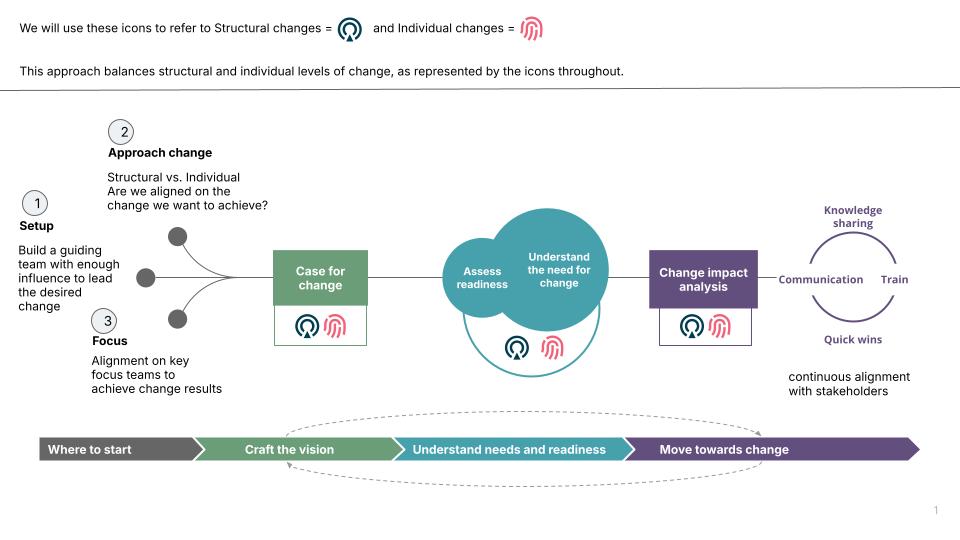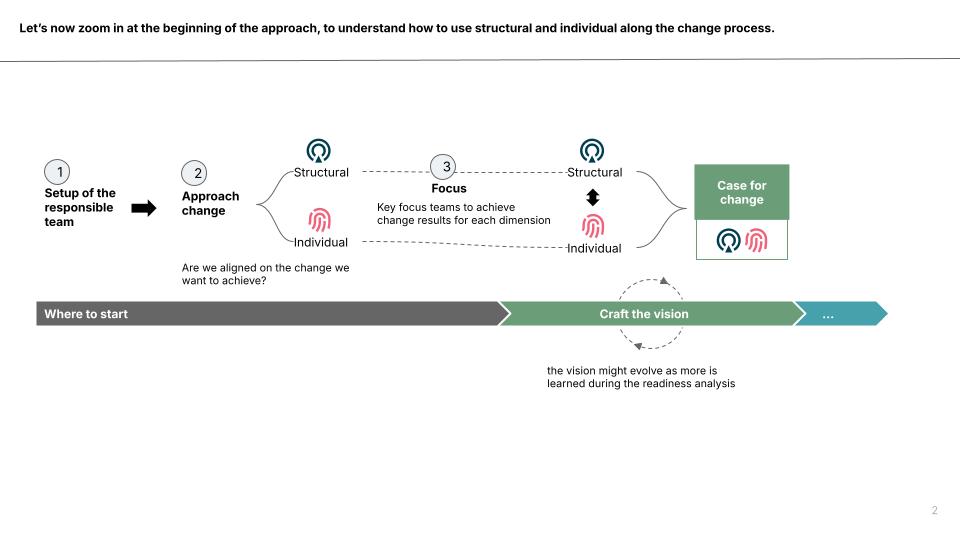Philips Healthcare is developing a new product and service platform — Health Suite Patient Monitoring Platform (HSPMP) — to address the significant challenges hospitals today face in rapidly deploying new patient monitoring technologies. The goal is to enable continuous delivery of software updates, ensuring hospitals have secure, reliable systems at all times and are able to run the same version of software across all systems.
Achieving this vision is no simple task. It requires a fundamental shift in terms of the organization’s entire operating model, which encompasses people, processes, product and systems. To begin to do this, gaining an understanding of the organization’s maturity and readiness for continuous delivery is essential. This involves clarifying the business and technical objectives of the Health Suite Patient Monitoring Platform (HSPMP) and then mapping out the current organizational design. In early 2024, Philips initiated the first of three two-month iterations for the design of the new target operating model, aligned with the first release of HSPMP FOK (First of Kind, which means it was intended as a first test release with customers), to ensure rapid progress and learning.
Silvia and Susan, your writers for this piece, had the pleasure of collaborating closely on this program, particularly around change management. As we learned from each other and came to appreciate our different perspectives, we felt compelled to share these reflections.
In this article, we’ll explore the importance of change management in enabling continuous delivery in the healthcare sector across different markets, focusing on the challenges we’ve encountered, the strategies we’ve deployed and the lessons we’ve learned along the way.
Navigating hospitals’ evolving landscape
Before diving into the details, let’s take a moment to step back and explore the intricate and ever-changing world of hospitals. Understanding this complexity is essential to grasp the challenges and opportunities we face in transforming patient care. Let us guide you through this journey, setting the stage for a deeper dive into the nuances of this critical topic.
In the rapidly evolving healthcare landscape, providers are adapting to broader industry pressures. These include digitizing patient management, enhancing the patient experience, and navigating the increasing complexity of modern practices and processes. To address these challenges, healthcare systems are redefining their care models and team structures.
Key trends in healthcare innovation
Trends such as data-driven resource management, centralized patient monitoring, automated decision tools and ‘Hospital to Home’ care models highlight the rapid innovation reshaping healthcare. These aren't isolated developments; they converge to create a foundation for continuous delivery in healthcare systems.
Continuous delivery serves as a framework for enabling constant improvements in healthcare operations, aligning care delivery with ever-evolving patient needs and technological advancements. Drawing from our project experience, this approach supports hospitals in:
Swiftly deploying new care models. By leveraging technologies like AI-driven resource optimization and virtual care models, hospitals can implement updates that enhance care delivery with minimal delay.
Seamlessly integrating new processes. Tools such as automated decision support systems enable healthcare providers to adopt new workflows and technologies with minimal disruption, ensuring a consistent focus on patient care.
Evolving care environments. The rise of Hospital to Home is a perfect example of how continuous delivery can work in healthcare architecture. By allowing care to be administered in the home setting, healthcare providers continuously refine and adapt their service offerings, creating a more flexible system for both patients and clinicians.
In this way, continuous delivery becomes the backbone of modern hospital architecture, enabling rapid, ongoing improvements to care models, technology integration and patient experience. These trends are interconnected, reinforcing the idea that healthcare systems must be agile, adaptable and always prepared for change.
Identifying the need for change
As hospitals evolve their approach to patient care, Philips must adapt to support them and ensure partnership in achieving their quadruple aim:
Enhanced patient experience.
Improved population health.
Reduced costs.
Improved care team wellbeing.
The move to cloud is enabled by the Health Suite Patient Monitoring Platform — a digital platform that helps healthcare providers monitor and manage patient experiences — supporting both in and out of hospital use cases. Beyond designing and releasing the platform, operationalizing it requires process and capability transformation on both Philips part and its customers.
Transformational challenges: a change management perspective
Change management as a discipline focuses on guiding organizations and individuals through transitions by addressing both the technical and human elements involved. Over the years, several frameworks have been developed to structure this process, and two models that have proven particularly effective are Kotter's 8-Step Model and the ADKAR Model. These models were both used in Philips Healthcare's transformation as each provided unique strengths, but neither alone offered a perfect solution for the complex change we were undergoing.
Kotter's 8-Step Model is a leadership-driven approach that emphasizes creating urgency, building coalitions and embedding change within an organization's culture. The eight steps include:
Establish a sense of urgency. Highlight the need for change to motivate people.
Form a powerful coalition. Build a guiding team with enough influence to lead the change.
Create a vision for change. Develop a clear and compelling vision to direct the initiative.
Communicate the vision. Use every possible channel to communicate the vision and strategy.
Remove obstacles. Identify and eliminate barriers that could slow or stop progress.
Create short-term wins. Aim for and celebrate early successes to maintain momentum.
Consolidate gains and produce more change. Use the momentum from early wins to tackle bigger challenges.
Anchor the changes in corporate culture. Ensure that the change becomes a lasting part of the organization’s culture.
The strength of Kotter’s model lies in its top-down approach, ensuring leadership is fully engaged in the process and focused on sustaining momentum. However, it is more centered on large-scale organizational leadership and less on individual change, which is where the ADKAR Model complements it.
The ADKAR Model, developed by Prosci, focuses more on the individual’s journey through change. It is a bottom-up approach that emphasizes five building blocks necessary for personal and organizational change:
Awareness. Understanding the need for change.
Desire. Having the personal motivation to engage and participate in change.
Knowledge. Knowing how to change and what the changes entail.
Ability. Developing the skills and behaviors required for successful change.
Reinforcement. Ensuring that changes are sustained over time and not lost.
ADKAR is particularly useful for breaking down change into manageable components and addressing the human emotions and behaviors associated with it. This model works well for guiding individuals through change by making them active participants in the process.
Our approach of using both models
Our journey involves adopting a continuous delivery model, transitioning to cloud-based operations, and fundamentally redefining how platforms and customers are supported. Both the organization and individuals had to undergo significant shifts in ways of working, capabilities and tooling.
This shift in the operating model introduces profound changes in both technological operations and the human dynamics of the organization. It goes beyond process optimization — it fundamentally reshapes workflows, redefines responsibilities and transforms how individuals perceive their roles within the company.
We want to highlight some of the most critical aspects of this evolution and their connection to the integration of ADKAR and Kotter's models. This will help you understand how our mixed frameworks address change challenges.
Shift from on-premises to cloud-based workflows
With updates no longer reliant on onsite visits, this change represents a significant shift for customers, as they adjust to a new support model that no longer includes in-person interactions. It also requires Philips employees to adapt to this new approach. Here we are focusing on the transition away from onsite support; the topic of downtime is not explored in depth.
Future updates will be performed remotely, enabling faster and more seamless service delivery, resulting in significantly less downtime. To support this shift, the dialog with the customer must start early in the sales process to build buy-in for this new way of working and ensure they fully understand the value it brings. Specifically, to enable continuous delivery, there must be an agreed-upon maintenance window during which the updates can flow freely.
Since updates will be remote, there will be a need to establish feedback mechanisms and prompt response channels for customers with questions, concerns or even to express appreciation. This transition shifts certain roles within the organization from a direct, one-to-one relationship with customers, to a more distant interaction model.
Here, we focus on analyzing the human aspect and ways of working, rather than the technical elements. How can Philips ensure that customers feel supported and confident with each programmed update, maintaining a sense of security and trust in the process?
In our view, this aligns with an individual change approach, such as the ADKAR model, for both Philips roles and our customers. For Philips, new job roles and skills are in focus, along with the need for a fundamental shift in mindset in our approach with customers. It is important for customer-facing folks to truly understand and believe in the need for this new way of working, in order to be able to “sell” our customers on why we (and they) need to transform, and why it is an advantage rather than a risk. We must demonstrate why the new approach is better, and offer customers an easy pathway to give feedback and voice their concerns. Continual reinforcement with ongoing communication will ensure that customers feel confident and supported.
Transition from local to global support model
On more traditional products and solutions, the local market provides service and support — including call center, triage and troubleshooting. With HSPMP, the focus is on continuous delivery and proactive support — detecting issues and addressing them before a customer is even aware. This new support model introduces organizational changes, transitioning to global, proactive monitoring of the platform. Local support teams, which previously held full ownership of customer support, now function primarily as a call center and triage point for platform issues. Most of the support is handled by a global team, ensuring 24/7 coverage.
This shift is significant at both the organizational and individual levels. At the organizational level, it involves establishing a new global support team, while at the individual level, roles are being redefined from providing comprehensive support to focusing on call handling and triage.
Designing and implementing this new organization requires clear role definitions, process adjustments, capability development and targeted training. Furthermore, the boundaries of the organization must be explicitly outlined — defining its inputs, outputs and methods of collaboration with other teams and departments.
Some roles within local market platform support are no longer required as they were before. Roles and responsibilities are redistributed and reconsidered, which can lead to uncertainty at the individual level. Team members may be unsure about their new boundaries, expectations, and areas of influence. When roles change, it often blurs familiar lines of accountability, which can create ambiguity around who is responsible for specific tasks or decisions. This shift requires individuals to adapt to new responsibilities, which can be particularly challenging if clear guidelines and support are not provided.
Additionally, employees may experience a temporary loss of confidence as they adjust to unfamiliar expectations and learn new processes, making it essential to have strong communication and support structures in place to ease the transition. This approach aligns with a large-scale change framework, such as Kotter's model.
Transitioning to a global model requires immediate recognition of the need for change. Kotter’s first step, creating a sense of urgency, is critical for breaking away from outdated localized practices and helping stakeholders understand the necessity of adopting new global structures. The shift impacts multiple departments, including support, platform teams and leadership.
We recommend identifying "change champions" across all levels of the organization to drive this transformation. These champions advocate for change, communicate its importance, address resistance, and inspire others to embrace the new direction. Together with a guiding coalition of influential leaders, change champions play a vital role in building momentum and ensuring sustained progress throughout the transformation process.
The shift to global operations requires clear communication of the new operating model and the benefits it brings. Kotter’s model emphasizes creating a compelling vision for the future, ensuring that employees understand the bigger picture and how their roles will evolve. The biggest challenge here is the cultural and mindset shift — getting teams to think globally rather than locally. Kotter’s final step emphasizes embedding these new practices into the organizational culture, ensuring that old patterns do not resurface and that global collaboration becomes the new norm.
As you may have read, given the scale and variety of the impact, we balanced our change management approach by combining elements of both Kotter's and ADKAR models. We also emphasized strong cross-functional collaboration to ensure engagement and transparency throughout the process. We are still on our change journey for this transformation. Some elements of the Kotter and ADKAR models were more strategic (vision for change) and others more tactical, such as the change impact assessment (understanding down to the level of impact to role, process and tools), and we used the portions that we deemed most useful. Currently, we have fully engaged all of those who are initially impacted and are working on transitioning ways of working. It is not a linear process, but rather an iterative process.
Lessons learned
If we could go back in time, we’d balance structural and individual changes within specific teams during our transformation. In our early change management working sessions we explored the challenges each team faced in adapting to the future operating model. This approach helped us gain a comprehensive overview of all organizational patterns and dynamics. However, focusing on challenges with just the Support team, or just the Platform team would have enabled deeper insights and more visible progress.
Why balance both structural and individual changes within one team? While focusing on one team enables depth and clarity, it’s essential to bring both the broader structural and individual aspects along throughout the transformation. This ensures the execution remains clear and aligned across teams even if progress happens at varying paces. For instance, with the new Support process, the organizational shifts and individual changes required represent a significant transformation on their own. Balancing these dimensions creates a solid foundation for change to spread effectively throughout the organization.


This learning shaped how we would approach transformation in the future: balance structural and individual dimensions throughout the transformation process. The graphic below illustrates how we would do this at the start of a project.


Set up a responsible team and align on outcomes.
Pair structural changes (processes, roles, systems) with individual changes (skills, behaviors, mindsets).
Define and communicate a clear case for change.
Start with a single focus area to build trust and momentum, delivering measurable results early. Tailor communication to different stakeholders and ensure everyone understands and embraces the change.
Do you, as a leader, know the end goal? Do your people understand it?
Structural changes — updating processes, tools and systems — are often the "easier" part. The real challenge lies in helping individuals adapt to new ways of working and thinking. Empathy and communication are essential. By focusing on the "what," "why," and "how" of change, and supporting people through the journey, managers can foster confidence and engagement. Ultimately, change works best when individuals are ready and equipped to succeed.
Set up a responsible team and align on outcomes.
Pair structural changes (processes, roles, systems) with individual changes (skills, behaviors, mindsets).
Define and communicate a clear case for change.
Start with a single focus area to build trust and momentum, delivering measurable results early. Tailor communication to different stakeholders and ensure everyone understands and embraces the change.
Do you, as a leader, know the end goal? Do your people understand it?
Structural changes — updating processes, tools and systems — are often the "easier" part. The real challenge lies in helping individuals adapt to new ways of working and thinking. Empathy and communication are essential. By focusing on the "what," "why," and "how" of change, and supporting people through the journey, managers can foster confidence and engagement. Ultimately, change works best when individuals are ready and equipped to succeed.


















